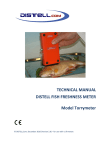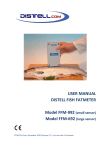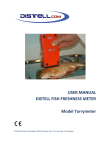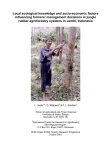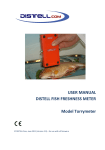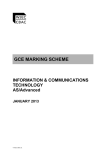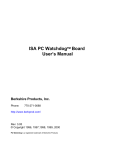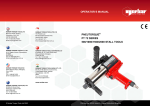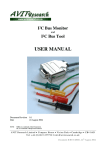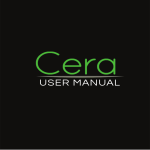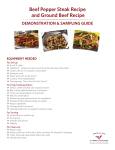Download Distell.com Step-by-Step Guide FFM
Transcript
STEP-BY-STEP GUIDE USE OF FISH FRESHNESS METER Distell.Com – Old Levenseat – Fauldhouse – West Lothian – EH47 9AD – Scotland – UK Tel : +44 (0)1501 770124 – Fax : +44 (0)1501 772424 Email : [email protected] - Website : www.distell.com STEP-BY-STEP GUIDE USE OF FISH FRESHNESS METER USE OF THE METER For daily use… Sensor Head Unit, Carry case with charging cradle, Mains Charger Unit. Switch On… Remove Meter from charging cradle. Verify that battery has been charged. The Meter is switched ON using the black selctor switch located beneath the display window. You can select a ONE-READING Position or a SIXTEEN READING position. When you switch ON the meter, a red LED will flash momentarily. This is your confirmation that the meter is ready for use. PLEASE READ YOUR USER MANUAL AND TAKE GOOD CARE OF THE METER. IT IS A MEASUREMENT INSTRUMENT AND SHOULD BE HANDLED CAREFULLY. Measurement of Product samples… It is important to follow the operating instructions contained in the User handbook. Full details are shown in the Handbook. Here is a quick check routine… • • • • • • • • You have chosen the correct setting….1 or 16 readings using the selector switch. You have checked to ensure that you have prepared, or been supplied with an Organoleptic Chart suitable for this fish species. Select the fish samples at random from the batch. Where you are taking fish samples from a variable batch, the samples should be grouped according to size. For best accuracy, always follow the measurement recommendations in your Handbook. Temperature of the fish to be measured should be between 0 – 10oC, with no ice crystals present in the samples. Ensure that the sensor is placed firmly against the skin of the fish, thus ensuring that there are no air pockets between the sensor and the sample to be measured. Press the Read button (at rear of meter) and a value will be displayed. For best results…BE CONSISTENT. Always place the sensor on the same part of the fish, day-to-day, this will ensure that you achieve optimum, comparable results. It is normal to experience variability in the individual readings when taken at different parts of the fish. Please note…different parts of the fish will spoil at different rates, depending upon the level of bacteriological activity present within the fish. ONE reading should be taken from each fish, at recommended measurement sites. The results should be evaluated using your Organoleptic Charts. Preparation of Product Samples, for sending to Laboratory… To compare the results achieved using the Freshness meter with a Laboratory Procedure, it is important that ALL of the fish carcass sample is packaged and sent to the laboratory for the analysis. The sample should be stored in a sealed polythene bag immediately after measurement and the temperature of the sample should be maintained as close to 0o C as possible. This will ensure that spoilage of the sample is reduced as far as possible. DO NOT ALLOW SAMPLE TO FREEZE 2 Here is a quick checklist for the laboratory… • • Whole carcass of the fish / fillet should be received at the lab. properly packed and sealed. The current "age from death" of the sample should be ascertained using standard laboratory methods…eg TVBN, etc. If the results from the Laboratory do not compare favourably with your meter…. check freshness meter use as follows… • • • Is the operator proficient in the use of the Fatmeter? Is the fish species the same as that quoted on your Organoleptic Chart? Check the product for species identification, measurement technique, size, and preparation. check Laboratory procedure as follows… • • Analytical method being used Sample preparation is OK If, after these checks there is still a siginficant difference, please contact Distell for advice and help. In conclusion…. This is just a short Check List on how to use and compare the Freshness Meter with other methods. Remember that the primary purpose in using the Freshness Meter is to screen a lot of product for Uniformity, Specification, Shelf Life, and to identify Frozen Fish. During the measurement process, finite accuracy is not the objective…the object is to try and ensure that the bulk of the day's raw materials and processed production meets with your specifications time after time. We have also attached answers to commonly asked questions, for your information. If you require any help or advice, please contact…. Mr David Fulton or Mr John Riordan at Distell .com Tel…. 01501 770124 Fax… 01501 772424 E-mail…[email protected] WE'RE HERE TO HELP ! 3 FISH FRESHNESS METER…. GUIDANCE ON PREPARATION OF AN ORGANOLEPTIC CHART The Fish Freshness Meter “Torrymeter” is used around the world as an objective method of measurement of freshness of fish caught, processed and sold. The Torrymeter allows an objective method of assessing the relative freshness of the fish simply and easily. Also, the meter is exceptionally useful for identifying fish that have been previously frozen by displaying a value of "4 or less" - even although the fish looks very fresh and wholesome. Some basic advice … Step 1 Before using the Freshness meter on a fish species, ensure that you have a Freshness Chart / Organoleptic Chart for the fish species that you intend to measure. If the fish species is not already specified in the Handbook, then you need to prepare a new chart. Step 2 To prepare a chart please adopt the following procedure. This is quite easily done using the Torrymeter to measure one or two fish over a period of 1- 2 weeks…. • • • • • Step 3 Procure 1 or 2 fish from the local market or, better still, fish freshly caught at sea. Immediately store the fish in ice, and maintain at or just above 0o C. Do not allow the fish to become frozen…as this destroys the cellular structure. The meter will display a value of "4 or less", where fish have been allowed to freeze. Measure the fish as recommended in the Handbook, ensuring that you measure consistently at the same position on the fish each time. Measure the fish twice per day … in the morning and in the evening…and keep a note of the readings. Continue the process until the fish is spoiled. Using this information prepare your Freshness Chart and, if possible, have your new Freshness Chart checked by an experienced fisherman or fish expert who can help validate your results. When finished, your Freshness Chart should resemble the attached charts for Cod and Salmon…. 4 ORGANOLEPTIC ANALYSIS RAW ODOUR AND COOKED FLAVOUR COD ( Gadus morhua) Raw Odour Description Cooked Flavour Description Fresh sea-weedy odours Watery, metallic, starchy Initially no sweetness but meaty flavours with slight sweetness may develop. Taste Panel Score Freshness Meter Score No. of Days on Ice EC Grade State of Spoilage 10 16 <2 E Very Fresh Shellfish odours and loss of fresh sea-weediness Sweet, meaty, creamy, green plant Characteristics 9 14 2–4 E No odours, odours. Sweet and flavours but intensity. 8 13 5–6 A neutral characteristic reduced in Slightly musty, mousy, milky or caprylic and similar odours, garlic, peppery. Neutral 7 11 8–9 A Bread, malt, beer yeasty odours Insipid, no flavours 6 10 ~ 11 B Lactic acid, sour milk or oily odours. Trace of “off” flavours, some sourness but no bitterness. 5 8 ~ 14 B Grass, “old boots”, slightly sweet, fruity or chloroform-like odours. Some “off” flavours, sourness and bitterness. 4 7 ~ 16 Not Graded Stale cabbage water, turnip, sour sink, wet matches, phosphene-like odours. Strong bitter flavours, rubber, sulphide-like. 3 5 ~ 18 Not Graded 2 <3 > 18 Not Graded Ammonia, strong “byrelike” odours. Strong ammonia, bad eggs, (hydrogen sulphide) Inedible 1 <3 >18 Not Graded Putrid, sulphides. Inedible 0 <3 > 18 Not Graded 5 Decrease In Freshness Nearly Spoiled Putrid ORGANOLEPTIC ANALYSIS RAW ODOUR AND COOKED FLAVOUR ATLANTIC SALMON (Salmo, Oncorhynchus) Raw Odour Description Cooked Flavour Description Fresh sea-weedy odours Watery, metallic, starchy Initially no sweetness but meaty flavours with slight sweetness may develop. Taste Panel Score Freshness Meter Score No. of Days on Ice EC Grade State of Spoilage 10 14 <2 E Very Fresh Shellfish odours and loss of fresh sea-weediness Sweet, meaty, creamy, green plant Characteristics 9 12 2–4 E No odours, odours. Sweet and flavours but intensity. 8 10 5–6 A neutral characteristic reduced in Slightly musty, mousy, milky or caprylic and similar odours, garlic, peppery. Neutral 7 9 8–9 A Bread, malt, beer yeasty odours Insipid, no flavours 6 8 ~ 11 B Lactic acid, sour milk or oily odours. Trace of “off” flavours, some sourness but no bitterness. 5 7 ~ 14 B Grass, “old boots”, slightly sweet, fruity or chloroform-like odours. Some “off” flavours, sourness and bitterness. 4 6 ~ 16 Not Graded Stale cabbage water, turnip, sour sink, wet matches, phosphene-like odours. Strong bitter flavours, rubber, sulphide-like. 3 5 ~ 18 Not Graded 2 <5 > 18 Not Graded <5 >18 Not Graded > 18 Not Graded Ammonia, strong “byrelike” odours. Strong ammonia, bad eggs, (hydrogen sulphide) Inedible 1 Putrid, sulphides. Inedible 0 6 <5 Decrease In Freshness Nearly Spoiled Putrid ANSWERS TO COMMONLY ASKED QUESTIONS 7 THE DISTELL FISH FRESHNESS METER Answers to commonly asked questions…. What is the main use of the Fish Freshness Meter ? Its main use is to measure the relative freshness of Wet Fish…WHOLE FISH & FILLETS eg. Cod, Whiting, Herring, Mackerel, Tilapia, etc. In fact, the meter can be used to measure freshness of most fish species caught and processed around the world. The meter is used for various applications, such as… • To estimate the freshness and quality of fish • To grade fish according to European Standards ( E-A-B) • To determine if fish has been frozen or irradiated • To estimate Shelf Life • To check the age of fish during Angling Competitions Do normal laboratory tests still need to be carried out ? YES…BUT NOT SO MANY, because the Freshness Meter is designed to allow many measurements to be taken to routinely screen the product. Occasional laboratory tests can be used as a support to confirm the results, and as a means of calibrating the instrument. Because the rate of spoilage varies from species to species, it is necessary to have a calibration chart for each species. Can samples be used after testing ? YES…because the Freshness Meter is NON-DESTRUCTIVE . You can measure the same sample many times if necessary without affecting the quality of the fish. How fast is the measurement ? The Freshness Meter has TWO measurement methods available…. 1. 2. Single Reading on 1 Fish. This takes around 10 seconds. Sixteen Readings taken on 16 individual Fish selected at random from a batch. This takes around 2-3 minutes depending on operator experience. Is it Waterproof ? YES…the case is waterproof and conforms to IP65 standards. This allows the Freshness Meter to be used in very wet environments such as Fish Auctions, Sea Ports and processing Plants. 8 THE DISTELL FISH FRESHNESS METER Answers to commonly asked questions…continued Is it really Portable ? YES… unlike other methods, it is a HAND-HELD instrument powered by rechargeable batteries. The Freshness Meter will operate for up to 24 HOURS continuously. How accurate is the Freshness Meter ? On un-irradiated, unfrozen/ thawed fish the accuracy of the Freshness Meter is equivalent to +/- 1day on ice. ( this depends upon species and handling). Are there any other benefits ? It is a tool for both the trained and untrained personnel in the Fish Industry. It is easy to use and allows the rapid, objective assessment of a large number of fish… unlike other methods of assessment using sight, taste and smell which can be very subjective. The Freshness Meter is never tired, never takes a holiday, and gives consistent readings day after day. It is environmentally friendly, safe to use, and in many cases will pay for itself within a few months. What precautions should I take when comparing Fish Freshness Meter results with laboratory analysis ? This is a very important question, and great care should be taken to ensure rigorous attention to detail….Where you know that the measurements made by the Freshness Meter are going to be compared to some form of Laboratory Analysis, always ensure a rigorous preparation procedure. Otherwise you may get a different result from the laboratory, and this will create confusion and doubt. The preparation instructions are clearly described in the Freshness Meter Handbook, but for the avoidance of doubt we have given a brief description here, as follows…. Switch the Freshness Meter ON by selecting position 1 or position 16 using the selector switch located under the display. A small, RED LED will illuminate momentarily. This confirms that the Meter is ON and ready for use. You are now ready to take measurements…. Please ensure that the readings are taken from the sample at the recommended measurement sites ( fully described in your handbook.) Place the sensor head fully in contact with the sample, being careful to exclude any air cavities. Press and hold the ‘READ’ button until the Red LED goes out…indicating that the reading has been taken. If you have chosen to measure just ONE fish, the value for that sample will now appear on the display. However, if you have chosen to measure SIXTEEN fish, the LED will light confirming that each measurement has been recorded, but no value will appear on the display until ALL SIXTEEN fish have been measured and the average calculated by the Meter. 9 THE DISTELL FISH FRESHNESS METER Answers to commonly asked questions…continued It is important to be consistent. Always place the sensor in the same location each time. This will ensure consistent and comparable results day-to-day…month-to-month. It is normal for the Freshness Meter to give a different value at different measurement sites on the same fish. Different parts of the fish will spoil at different rates due to the bacteria levels, fat content, muscle structure, and cell disruption within the fish. Does temperature affect the performance or results achieved using the Freshness Meter? Provided that the Fish or Fish Fillets being measured with the Freshness Meter contains no ice crystals, temperature should have no significant effect. Where the Fish or Fish Fillets have been previously frozen or contain ice crystals, the Freshness Meter will display a very low value ( normally between 1-4 ). The reason for this is that the act of freezing the fish disrupts the cell structure within the fish…this affects the capacitance and conductivity within the flesh of the fish, similar to the cellular breakdown caused by bacteriological activity. This low value, displayed by the meter, infers that this change in conductivity is spoilage. Of course, where the fish has indeed been frozen, the fish looks very fresh and of high quality….and is not normally spoiled or smelly. The Freshness Meter serves as a useful quality check for fish buyers as the shelf life of previously frozen fish is significantly lower than that of fish which have been stored properly at or slightly above 0o C since being caught. • We have found that Fish and Fish Fillets down to –2o C normally do not contain ice crystals…and can be measured as normal. • We have also found that Fish or Fish Fillets, stored at or above 10o C, can suffer moisture loss, and create a variance from the Natural Fish State. For consistent, wholly accurate results, the operator should ensure that the Fish or Fish Fillets are measured at the same ambient temperature on a daily basis….within a temperature range of 0 – 10o C . What species of Fish can I measure using the Fish Freshness Meter ? The measurements displayed by the Freshness Meter are based upon a simple value scale between 1 to 16. The higher the displayed value, the fresher the fish. This means that the Freshness meter can be used to measure most species of fish caught and processed around the world. We simply produce an Organoleptic Chart for each fish species that we wish to measure. How do I create an Organoleptic Chart ? There are numerous fish species around the world. Each country has a number of "Taste Panels", whose job it is to create standards for the quality of fish caught and processed in their own region. The quality of fish landed and processed is then adjudged using the "Taste Panel" standards as a base for comparison. 10 THE DISTELL FISH FRESHNESS METER Answers to commonly asked questions…continued …./.. Distell have created Organoleptic Charts for most species in European Waters. However, it is quite easy to prepare your own, as follows… Firstly…The Criteria you wish to list.. • Decide on the information that you wish to be included in your Chart. For instance…Distell's charts contain the following information… (i) (ii) (iii) (iv) (v) (vi) (vii) Raw odour description, normally available from taste panels in your country Cooked flavour description, normally available from taste panels in your country Taste panel scores, which illustrate a value for freshness Relative age of the fish, based upon taste panel scores, and equivalent to the "Number of Days in Ice at 0o C, but not allowed to freeze ". EC Grading standards as agreed by the European Community, again adjudged by reference to "taste panel scores" An indication of the state of freshness. And finally, the value shown by the Freshness Meter, calibrated to compare against other criteria listed above. Secondly…Preparation of the chart… Obtain samples of the fish for which you wish to create a chart. Ensure that you know the age of the fish from the moment of catch / death. Ensure that you know that the fish has been handled and stored under optimum conditions. • • • • • Procure 1 or 2 fish from the local market or, better still, fish freshly caught at sea. Immediately store the fish in ice, and maintain at or just above 0o C. Do not allow the fish to become frozen…as this destroys the cellular structure. The meter will display a value of "4 or less", where fish have been allowed to freeze. Measure the fish as recommended in the Handbook, ensuring that you measure consistently at the same position on the fish each time. Measure the fish twice per day … in the morning and in the evening…and keep a note of the readings. Continue the process until the fish is spoiled. Using this information prepare your Freshness Chart and, if possible, have your new Freshness Chart checked by an experienced fisherman or fish expert who can help validate your results and help you set the values against other measures of freshness. When finished, your Freshness Chart should resemble the attached Organoleptic Charts for Cod and Salmon. 11 FISH FRESHNESS METER GUIDANCE FOR ANGLING CLUB COMPETITIONS The Fish Freshness Meter “Torrymeter” is used around the world as an objective measurement of freshness of fish caught at various angling competitions. With ever increasing prize money at stake, many competitors try to beat the system by having a suitable fish caught and stored in ice (or frozen) outwith the competition window. The fish is then presented as having been caught within the competition and the prize money claimed. The Torrymeter allows an objective method of assessing the relative freshness of the competition fish simply and easily. Also, the meter is exceptionally useful for identifying fish that have been previously frozen by displaying a value of "4 or less even although the fish looks very fresh and wholesome. Some basic advice … Step 1 Before the competition date, ensure that you have a Freshness Chart / Organoleptic Chart for the fish species that you intend to fish. If the fish species is not already specified in the Handbook, then you need to prepare a new chart. Step 2 If you require to prepare a chart then please adopt the following procedure. This is quite easily done using the Torrymeter to measure one or two fish over a period of 1- 2 weeks…. • • • • • Procure 1 or 2 fish from the local market, or better still, fish freshly caught at sea. Immediately store the fish in ice, and maintain at or just above 0o C. Do not allow the fish to become frozen…as this destroys the cellular structure. The meter will display a value of "4 or less" where fish have been allowed to freeze. Measure the fish as recommended in the Handbook, ensuring that you measure consistently at the same position on the fish each time. Measure the fish twice per day … in the morning, and in the evening…and keep a note of the readings. Continue the process until the fish is spoiled. Step 3 Using this information prepare your Freshness Chart, and if possible, have your new Freshness Chart checked by an experienced fisherman or fish expert who can help validate your results. Step 3 Arrange that ALL fish caught during the competition are measured using the Torrymeter. Relate the measurement to your Freshness Chart. Step 4 Any fish that show a significant difference in freshness value from the average should be further investigated. When finished, your Freshness Chart should resemble the attached Charts for Cod and Salmon. 12


















